
A fallout shelter is an enclosed space specially designated to protect occupants from radioactive debris or fallout resulting from a nuclear explosion. Many such shelters were constructed as civil defense measures during the Cold War.

Nuclear fallout is the residual radioactive material propelled into the upper atmosphere following a nuclear blast, so called because it "falls out" of the sky after the explosion and the shock wave has passed. It commonly refers to the radioactive dust and ash created when a nuclear weapon explodes. The amount and spread of fallout is a product of the size of the weapon and the altitude at which it is detonated. Fallout may get entrained with the products of a pyrocumulus cloud and fall as black rain. This radioactive dust, usually consisting of fission products mixed with bystanding atoms that are neutron-activated by exposure, is a form of radioactive contamination.
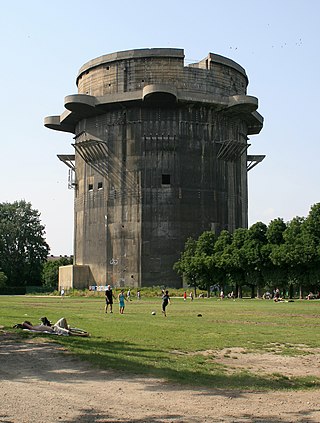
A bunker is a defensive military fortification designed to protect people and valued materials from falling bombs, artillery, or other attacks. Bunkers are almost always underground, in contrast to blockhouses which are mostly above ground. They were used extensively in World War I, World War II, and the Cold War for weapons facilities, command and control centers, and storage facilities. Bunkers can also be used as protection from tornadoes.

The Nevada National Security Site, known as the Nevada Test Site (NTS) until 2010, is a United States Department of Energy (DOE) reservation located in southeastern Nye County, Nevada, about 65 miles (105 km) northwest of the city of Las Vegas. Formerly known as the Nevada Proving Grounds, the site was established in 1951 for the testing of nuclear devices. It covers approximately 1,360 square miles (3,500 km2) of desert and mountainous terrain. Nuclear weapons testing at the site began with a 1-kiloton-of-TNT (4.2 TJ) bomb dropped on Frenchman Flat on January 27, 1951. Over the subsequent four decades, over 1,000 nuclear explosions were detonated at the site. Many of the iconic images of the nuclear era come from the site.

Protect and Survive was a public information campaign on civil defence. Produced by the British government between 1974 and 1980, it intended to advise the public on how to protect themselves during a nuclear attack. The campaign comprised a pamphlet, newspaper advertisements, radio broadcasts, and public information films. The series had originally been intended for distribution only in the event of dire national emergency, but provoked such intense public interest that the pamphlet was published, in slightly amended form, in 1980. Due to its controversial subject, and the nature of its publication, the cultural impact of Protect and Survive was greater and longer-lasting than most public information campaigns.

Air raid shelters are structures for the protection of non-combatants as well as combatants against enemy attacks from the air. They are similar to bunkers in many regards, although they are not designed to defend against ground attack.

Continuity of government (COG) is the principle of establishing defined procedures that allow a government to continue its essential operations in case of a catastrophic event such as nuclear war.

A storm shelter or storm cellar is a type of underground bunker designed to protect the occupants from violent severe weather, particularly tornadoes. They are most frequently seen in the Midwest and Southeastern United States where tornadoes are generally frequent and the low water table permits underground structures.

"Duck and cover" is a method of personal protection against the effects of a nuclear explosion. Ducking and covering is useful in offering a degree of protection to personnel located outside the radius of the nuclear fireball but still within sufficient range of the nuclear explosion that standing upright and uncovered is likely to cause serious injury or death. In the most literal interpretation, the focus of the maneuver is primarily on protective actions one can take during the first few crucial seconds-to-minutes after the event, while the film of the same name and a full encompassing of the advice also cater to providing protection up to weeks after the event.

Duck and Cover is a 1952 civil defense animated live-action social guidance film that is often popularly mischaracterized as propaganda.

The Diefenbunker, formerly known by its military designation, Canadian Forces Station Carp (CFS Carp), is a large underground four-storey reinforced concrete bunker and nuclear fallout shelter located in the rural area of Carp, Ontario approximately 30 km (19 mi) west of downtown Ottawa. Between 1957 and 1961, during the Cold War the Government of Canada led by then Prime Minister John Diefenbaker authorized the Diefenbunker to be designed and built as the Central Emergency Government Headquarters (CEGHQ Carp) in an attempt to ensure the continuity of government subsequent to a nuclear weapons attack by the Soviet Union. In 1994, CFS Carp was decommissioned and closed.

A blast shelter is a place where people can go to protect themselves from blasts and explosions, like those from bombs, or in hazardous worksites, such as on oil and gas refineries or petrochemical facilities. It differs from a fallout shelter, in that its main purpose is to protect from shock waves and overpressure instead of from radioactive precipitation, as a fallout shelter does. It is also possible for a shelter to protect from both blasts and fallout.
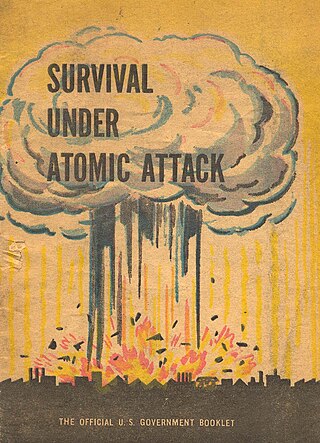
Survival Under Atomic Attack was the title of an official United States government booklet released by the Executive Office of the President, the National Security Resources Board, and the Civil Defense Office. Released at the onset of the Cold War era, the pamphlet was in line with rising fears that the Soviet Union would launch a nuclear attack against the United States, and outlined what to do in the event of an atomic attack.
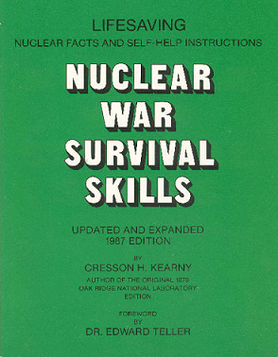
Nuclear War Survival Skills or NWSS, by Cresson Kearny, is a civil defense manual. It contains information gleaned from research performed at Oak Ridge National Laboratory during the Cold War, as well as from Kearny's extensive jungle living and international travels.

Abo Elementary School in Artesia, New Mexico, United States, was the first public school in the United States constructed entirely underground and equipped to function as an advanced fallout shelter. Designed at the height of the Cold War and completed in 1962, the school had a concrete slab roof which doubled as the school's playground. It contained a large storage facility with room for emergency rations and supplies for up to 2,160 people in the event of nuclear warfare or other catastrophe. The building was listed on the National Register of Historic Places in 1999.

Stalin's bunker is an air raid shelter located near Samara State University of Culture in Samara, Russia. It is a subterranean bunker complex constructed between February and October 1942. It was the alternative Supreme High Command General Headquarters of the Soviet Armed Forces intended for Joseph Stalin during World War II. Stalin's Bunker is located 37 metres (121 ft) beneath the Kuybyshev CPSU oblast Committee building, 100 metres (110 yd) south-east of the Samara Academy Theater. Stalin's Bunker was declassified in 1990. Now the civil defence museum occupies the former air raid shelter. The air-raid shelters for the Soviet High Command were built also in Yaroslavl, Gorky, Kazan, Ulyanovsk, Saratov and Stalingrad.
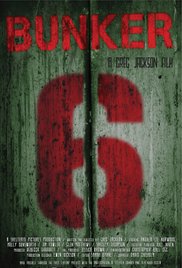
Bunker 6 is a Canadian psychological thriller film set in an alternate timeline in which a nuclear holocaust takes place during the Cuban Missile Crisis. Most of the film's action is set a decade later, inside a very large fallout shelter, in which a group of survivors are faced with the dilemma of continuing life in the shelter or facing the uncertainty of life in a world contaminated by radiation. Theatrically released, the film was also destined for television and "direct-to-video" release. Directed by Canadian writer and director Greg Jackson, in his first feature film, it stars Andrea Lee Norwood and Molly Dunsworth. The supporting cast includes Jim Fowler, Glen Matthews and Shelley Thompson. The film was shot in an actual fallout shelter in Nova Scotia.
Clayton "Sam" Samuel White was an American physician, nuclear physicist and medical researcher best known for developing the field of “blast and shock biology” which explored the effects of blast and shock waves from nuclear bombs and other explosions. By bringing together the disciplines of mathematics, physics, biology and anatomy, White was able to measure the impact of nuclear weapons on physical structures and the human body.
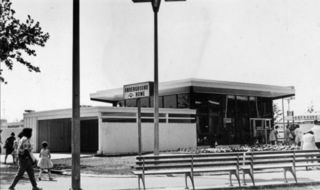
Underground World Home was a home designed for the 1964 New York World's Fair by architect Jay Swayze. The home-exhibit was in Flushing Meadow Park in Queens and appeared to be a luxury bomb shelter which was marketed as secure and safe.

Julian Harvey "Jay" Swayze was an architect from Plainview, Texas best known for his creation of Underground World Home at the 1964 New York World's Fair. During his career he was a promoter of underground living and he wrote a book called: Underground gardens & homes: The best of two worlds, above and below.

















